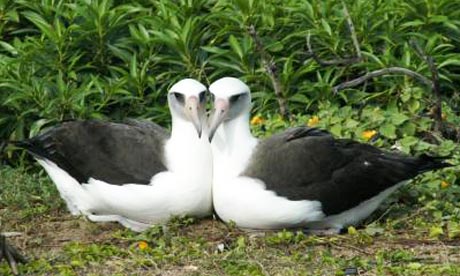
Almost a third of Laysan albatross couples are female-female pairs that build nests and rear young together. They are more reproductively successful than unpaired females. Photograph: Eric VanderWerf/Trends in Ecology & Evolution
Birds do it. Bees probably do it. No one's sure whether educated fleas do it. What they do is have same-sex relationships and, in a new review of published research on the subject, biologists have started to consider what it might mean for the evolution of the animals in question.
Nathan Bailey and Marlene Zuk, biologists at the University of California, Riverside, found that same-sex relationships were a universal phenomenon in the animal kingdom, seen in everything from worms to frogs to birds. "It's clear that same-sex sexual behavior extends far beyond the well-known examples that dominate both the scientific and popular literature: for example bonobos, dolphins, penguins and fruit flies," said Bailey.
Penguins have been known to form long-term same-sex bonds where males will engage in sexual activity. Toads generally don't discriminate between sexes while marine snails all start out male and, when they mate with another male, one of them helpfully changes sex. Dolphins will often touch their genitals together or one male might even mount another and penetrate its blowhole. Bonobos go the furthest in same-sex bonding with regular copulation among males.
But not all relationships should be considered the same. A male fruit fly, for example, may court other males because it lacks a gene that allows it to tell the difference between the sexes. "But that is very different from male bottlenose dolphins, who engage in same-sex interactions to facilitate group bonding, or female Laysan albatross that can remain pair-bonded for life and cooperatively rear young," said Bailey.
Writing in the journal Trends in Ecology & Evolution, the authors said that lots of previous studies had considered how same-sex relationships might have come about but very few studies had considered whether the relationships shape the course of evolution.
"Same-sex behaviors – courtship, mounting or parenting – are traits that may have been shaped by natural selection, a basic mechanism of evolution that occurs over successive generations," Bailey said. "But our review of studies also suggests that these same-sex behaviors might act as selective forces in and of themselves."
In other words same-sex relationships might shape evolution in subtle and important ways for many animals. When bilogists think about selective pressure in evolution, they tend to focus on environmental concerns such as weather, temperature, or geographic features in a particular locality. Social circumstances can also have an impact and Bailey argues that same-sex relationships could "radically change those social circumstances, for example by removing some individuals from the pool of animals available for mating."
In addition, the behaviour can lead to the evolution of defence mechanisms. "For example, male-male copulations in locusts can be costly for the mounted male, and this cost may in turn increase selection pressure for males' tendency to release a chemical called panacetylnitrile, which dissuades other males from mounting them," said Bailey.
Bailey and Zuk are also researching the Laysan albatross, a species in which females form same-sex pairs and rear young together. "Same-sex behavior in this species may not be aberrant, but instead can arise as an alternative reproductive strategy," they said.
Almost a third of Laysan albatross couples are female-female pairs and they are more successful than unpaired females when it comes to rearing chicks.
"Same-sex sexual behaviors are flexibly deployed in a variety of circumstances, for example as alternative reproductive tactics, as cooperative breeding strategies, as facilitators of social bonding or as mediators of intrasexual conflict. Once this flexibility is established, it becomes in and of itself a selective force that can drive selection on other aspects of physiology, life history, social behaviour and even morphology," said Bailey.
Same-sex relationships may play an important role in evolution
ScienceDaily - Same-sex Behavior Seen In Nearly All Animals, Review Finds
Sem comentários:
Enviar um comentário